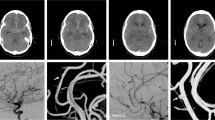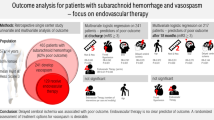Abstract
Background
Vasospasm, delayed infarcts and clinical deterioration due to delayed cerebral ischemia (CD-DCI) following digital subtraction angiography (DSA)-negative, spontaneous subarachnoid hemorrhage (SAH) are infrequently and inconsistently described in the literature.
Methods
To quantify and characterize rates of each, we reviewed our own series of 77 patients with DSA-negative, spontaneous SAH. Employing a PubMed search, we reviewed the literature and calculated directly adjusted overall rates of vasospasm, delayed infarcts and CD-DCI.
Results
In our own patient cohort, 26 % of patients suffered vasospasm, 4 % delayed infarcts and 4 % CD-DCI. Higher Hunt-Hess grade and diffuse SAH pattern were associated with higher rates of each. Incorporating results from 18 studies in the literature, the directly adjusted overall rate of vasospasm following DSA-negative SAH was 16.3 % (95 % CI 12.3-21.1). Adjusted overall rates of delayed infarcts and CD-DCI were 3.4 % (95 % CI 1.9-5.5) and 6.8 % (95 % CI 5.0-9.1), respectively. For the subgroup of patients with diffuse SAH, the rates of vasospasm and CD-DCI were 31.3 % (95 % CI 21.6-43.9) and 9.7 % (95 % CI 7.0-13.0), respectively, while in patients with perimesencephalic SAH, respective rates were 13.1 % (95 % CI 7.7-20.7) and 2.4 % (95 % CI 1.0-4.8). A mixed-effects meta-analysis revealed an odds ratio for CD-DCI in diffuse SAH compared to perimesencephalic SAH of 3.79 (p = 0.009).
Conclusion
Although they are seen less frequently in patients with DSA-negative spontaneous SAH, vasospasm, delayed infarcts and CD-DCI do occur and may require endovascular therapy. Risk factors include a diffuse hemorrhage pattern and higher Hunt-Hess grade.


Similar content being viewed by others
References
Andaluz N, Zuccarello M (2008) Yield of further diagnostic work-up of cryptogenic subarachnoid hemorrhage based on bleeding patterns on computed tomographic scans. Neurosurgery 62:1040–1047
Artiola Fortuny L, Prieto-Valiente L (1981) Long-term prognosis in surgically treated intracranial aneurysms. Part 2: morbidity. J Neurosurg 54:35–43
Barlow P (1992) Incidence of delayed cerebral ischemia following subarachnoid hemorrhage of unknown cause. J Neurol Neurosurg Psychiatry 48:132–136
Brisman J, Sundbarg G (1985) Subarachnoid haemorrhage of unknown origin: prognosis and prognostic factors. J Neurosurg 63:349–354
Canhao P, Ferro JM, Pinto AN, Melo TP, Campos JG (1995) Perimesencephalic and nonperimesencephalic subarachnoid haemorrhages with negative angiograms. Acta Neurochir (Wien) 132:14–19
Cioffi F, Pasqualin A, Cavazzani P, Da Pian R (1989) Subarachnoid hemorrhage of unknown origin: clinical and tomographical aspects. Acta Neurochir (Wien) 97:31–39
DerSimonian R, Laird N (1986) Meta-analysis in clinical trials. Control Clin Trials 7:177–188
Dorsch NWC, King MT (1994) A review of cerebral vasospasm in aneurysmal subarachnoid hemorrhage. Part 1: incidence and effects. J Clin Neurosci 1:19–26
Duong H, Melançon D, Tampieri D, Ethier R (1996) The negative angiogram in subarachnoid haemorrhage. Neuroradiology 38:15–19
Fisher CM, Roberson GH, Ojemann RG (1977) Cerebral vasospasm with ruptured saccular aneurysm—the clinical manifestations. Neurosurgery 1:245–248
Fontanella M, Rainero I, Panciani PP, Schatlo B, Benevello C, Garbossa D, Carlino C, Valfre W, Griva F, Bradac GB, Ducati A (2011) Subarachnoid hemorrhage and negative angiography: clinical course and long-term follow-up. Neurosurg Rev 34:477–484
Gupta SK, Gupta R, Khosla VK, Mohindra S, Chhabra R, Khandelwal N, Gupta V, Mukherjee KK, Tewari MK, Pathak A, Mathuriya SN (2009) Nonaneurysmal nonperimesecephalic subarachnoid hemorrhage: is it a benign entity? Surg Neurol 71:566–571
Hsu W, Pradilla G, Garonzik IM, Conway JE (2010) Pretruncal nonaneurysmal subarachnoid hemorrhage causing basilar artery vasospasm. Neurocrit Care 13:256–260
Hui FK, Tumialán LM, Tanaka T, Cawley CM, Zhang YJ (2009) Clinical differences between angiographically negative, diffuse subarachnoid hemorrhage and perimesencephalic subarachnoid hemorrhage. Neurocrit Care 11:64–70
Ildan F, Tuna M, Erman T, Gocer AI, Cetinalp E (2002) Prognosis and prognostic factors in nonaneurysmal perimesencephalic hemorrhage: a follow-up study in 29 patients. Surg Neurol 57:160–165
Kang DH, Park J, Lee SH, Park SH, Kim YS, Hamm IS (2009) Does non-perimesencephalic type non-aneurysmal subarachnoid hemorrhage have a benign prognosis? J Clin Neurosci 16:904–908
Kawamura S, Yasui N (1990) Clinical and long-term follow-up study in patients with spontaneous subarachnoid haemorrhage of unknown aetiology. Acta Neurochir 106:110–114
Qureshi AI, Sung GY, Razumovsky AY, Lane K, Straw RN, Ulatowski JA (2000) Early identification of patients at risk for symptomatic vasospasm after aneurysmal subarachnoid hemorrhage. Crit Care Med 28:984–990
Rinkel GJ, Wijdicks EFM, Hasan D, Kienstra GEM, Franke CL, Hageman LM, Vermeulen M, van Gijn J (1991) Outcome in patients with subarachnoid haemorrhage and negative angiography according to pattern of haemorrhage on computed tomography. Lancet 338:964–968
Ropper AH, Zervas NT (1984) Outcome 1 year after SAH from cerebral aneurysm. Management morbidity, mortality, and functional status in 112 consecutive good-risk patients. J Neurosurg 60:909–915
Schaller C, Rauseiser B, Rohde V, Hassler W (1996) Cerebral vasospasm after subarachnoid hemorrhage of unknown aetiology: a clinical and transcranial Doppler study. Acta Neurochir (Wien) 138:560–568
Schievink WI, Wijdicks EF, Spetzler RF (2000) Diffuse vasospasm after pretruncal nonaneurysmal subarachnoid hemorrhage. AJNR Am J Neuroradiol 21:521–523
Schwartz TH, Solomon RA (1996) Perimesencephalic nonaneurysmal subarachnoid hemorrhage: review of the literature. Neurosurgery 39:433–440
Sheehan JM, Cloft H, Kassell NF (2000) Symptomatic delayed arterial spasm following non-aneurysmal perimesencephalic subarachnoid hemorrhage: a case report and review of the literature. Acta Neurochir (Wien) 142:709–712
Topcuoglu MA, Ogilvy CS, Carter BS, Buonanno FS, Koroshetz WJ, Singhal AB (2003) Subarachnoid hemorrhage without evident cause on initial angiography studies: diagnostic yield of subsequent angiography and other neuroimaging tests. J Neurosurg 98:1235–1240
Van Calenbergh F, Plets C, Goffin J, Velghe L (1993) Nonaneurysmal subarachnoid hemorrhage: prevalence of perimesencephalichemorrhage in a consecutive series. Surg Neurol 39:320–323
Vergouwen MDI, Vermeulen M, Gijn J, Rinkel GJE, Wijdicks EF, Muizelaar JP, Mendelow AD, Juvela S, Yonas H, Terbrugge KG, Macdonald RL, Diringer MN, Broderick JP, Dreier JP, Roos Y (2010) Definition of delayed cerebral ischemia after aneurysmal subarachnoid hemorrhage as an outcome event in clinical trials and observational studies. Stroke 41:2391–2395
Whiting J, Reavey-Cantwell J, Velat G, Fautheree G, Firment C, Lewis S, Hoh B (2009) Clinical course of nontraumatic, nonaneurysmal subarachnoid hemorrhage: a single-institution experience. Neurosurg Focus 26:E21
Wijdicks EF, Schievink WI, Miller GM (1998) Pretruncal nonaneurysmal subarachnoid hemorrhage. Mayo Clin Proc 73:745–752
Conflicts of interest
None.
Author information
Authors and Affiliations
Corresponding author
Rights and permissions
About this article
Cite this article
Gross, B.A., Lin, N., Frerichs, K.U. et al. Vasospasm after spontaneous angiographically negative subarachnoid hemorrhage. Acta Neurochir 154, 1127–1133 (2012). https://doi.org/10.1007/s00701-012-1383-4
Received:
Accepted:
Published:
Issue Date:
DOI: https://doi.org/10.1007/s00701-012-1383-4




